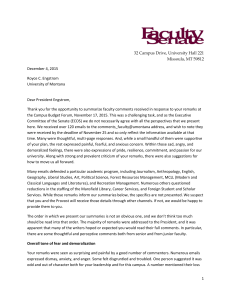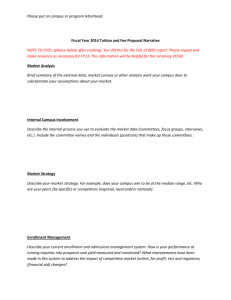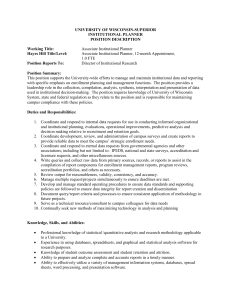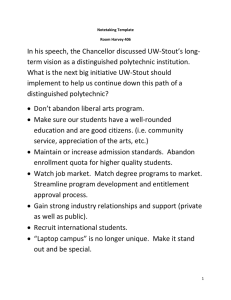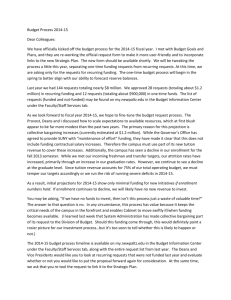1 32 Campus Drive, University Hall 221 Missoula, MT 59812
advertisement
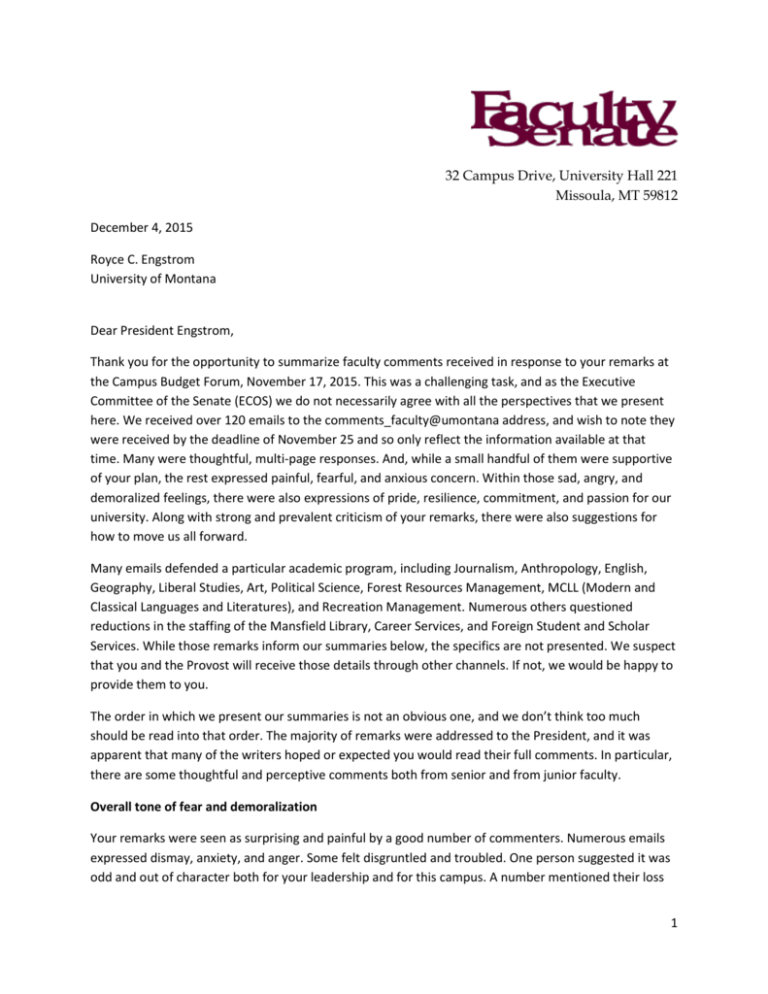
32 Campus Drive, University Hall 221 Missoula, MT 59812 December 4, 2015 Royce C. Engstrom University of Montana Dear President Engstrom, Thank you for the opportunity to summarize faculty comments received in response to your remarks at the Campus Budget Forum, November 17, 2015. This was a challenging task, and as the Executive Committee of the Senate (ECOS) we do not necessarily agree with all the perspectives that we present here. We received over 120 emails to the comments_faculty@umontana address, and wish to note they were received by the deadline of November 25 and so only reflect the information available at that time. Many were thoughtful, multi-page responses. And, while a small handful of them were supportive of your plan, the rest expressed painful, fearful, and anxious concern. Within those sad, angry, and demoralized feelings, there were also expressions of pride, resilience, commitment, and passion for our university. Along with strong and prevalent criticism of your remarks, there were also suggestions for how to move us all forward. Many emails defended a particular academic program, including Journalism, Anthropology, English, Geography, Liberal Studies, Art, Political Science, Forest Resources Management, MCLL (Modern and Classical Languages and Literatures), and Recreation Management. Numerous others questioned reductions in the staffing of the Mansfield Library, Career Services, and Foreign Student and Scholar Services. While those remarks inform our summaries below, the specifics are not presented. We suspect that you and the Provost will receive those details through other channels. If not, we would be happy to provide them to you. The order in which we present our summaries is not an obvious one, and we don’t think too much should be read into that order. The majority of remarks were addressed to the President, and it was apparent that many of the writers hoped or expected you would read their full comments. In particular, there are some thoughtful and perceptive comments both from senior and from junior faculty. Overall tone of fear and demoralization Your remarks were seen as surprising and painful by a good number of commenters. Numerous emails expressed dismay, anxiety, and anger. Some felt disgruntled and troubled. One person suggested it was odd and out of character both for your leadership and for this campus. A number mentioned their loss 1 of faith in the direction and approach taken and were embarrassed and saddened. In particular, some left hearing your remarks feeling dehumanized, demeaned, and disposable. As will be discussed below, as a result of your comments some faculty questioned whether their ongoing contribution and commitment to the university was welcome and respected. Quite a few emails also expressed concern that the proposed cuts will not be enough and will have to be repeated in future years. More specifically, several commenters pointed out that the proposed cuts are seemingly based on the assumption that enrolment will not further decline, and questioned whether this assumption is realistic given past performance. Lack of powerful vision for the university going forward Many comments expressed concern about the overall tone and language choice used in your remarks. Specifically, they noted words more commonly associated with business or corporate concerns such as fiscal responsibility, financial alignment, rightsizing, downsizing, consolidation, and adjustment of employee numbers. A number remarked that the specific naming and targeting of academic programs for personnel actions seems to be pitting programs against one another, which is in marked contrast to a collective, unified, strategic vision for our university. This competitive dynamic was evident in numerous comments received, which either noted the growing divide on campus or defended a program viewed as unfairly targeted in comparison with other programs. Further, some noted that neither the particular merits of academic programs nor their contributions to the campus strategic goals of student success, educating for the global century, discovery and creativity, and dynamic learning environments, were fully considered. Many of the comments noted the targeted programs’ success in inter-disciplinary, international, and online education, as well as their central role in educating students from many majors other than their own. Numerous comments called for a compelling and energetic vision for our university or encouraged a redoubling of our commitment to our core and distinguished mission as a flagship university committed to the liberal arts and research. Some commenters perceived your remarks as promoting scientific, technical, and vocational programs at the expense of the liberal arts and humanities. Many of those remarked that it is a false dichotomy because professional programs rely upon the critical thinking, communication, and problem-solving skills that the liberal arts develop. Comments also questioned the ability of the current leadership to chart a successful course out of the current predicament. There were calls either for a vote of no confidence or for letting administrators go from their current responsibilities. Unwise and unhealthy competition with MSU for students and funding Numerous comments questioned the wisdom of what appears to be an escalating competition with Montana State University for in-state students and funding, which UM is currently losing. These commenters blamed the BOR for pitting the schools against each other by tying state-funded dollars to enrollment while at the same time freezing tuition. They note that this has meant that UM has lost millions of dollars in funding in recent years, largely due to events beyond its control, yet it cannot offset 2 those losses by increasing revenue, even in an emergency such as this one. UM administrators were also criticized for not working effectively to represent UM’s interests before the BOR. The fact that MSU has long been allowed to charge higher tuition for in-state undergraduate students was questioned. Several commenters stated that MSU is, or at least appears to be, the BOR’s favored institution and urged a more balanced and unified approach to higher education in Montana. There were also calls for less duplication of programs between the two campuses. Questions about the metrics and data used The heavy reliance on enrollment in academic majors was frequently questioned. Many emails suggested alternate program measures, such as headcount, student credit hour (SCH), instructional expenditure, course load per faculty, and time to graduation. A number questioned the short timeframes used to identify enrollment patterns, as well as the particular timing of those measurements. Quite noticeably, many faculty wondered why second or double majors weren’t counted, nor minors, graduate students, or service contributions to General Education, interdisciplinary, and school- or college-wide programs. Indeed, faculty from some programs that had been identified as “positioned for growth” noted the requirements for their degree program that are offered by targeted units. Other measures of student success were frequently mentioned, such as awards (eg. Fulbright, Udall, Goldwater, and Critical Language Scholarships), GRE scores, graduate program admission levels, and other measures of quality instruction and mentoring. There was a general call for more easily accessible data on the specific additions in personnel in the years since 2008 -- broken out specifically into faculty, staff, administrative, and contract professionals. Some wanted program-, unit-, and college/school-level data, particularly student-to-faculty ratios. Some faculty in targeted programs said those programs had not seen increases in faculty, staff or resources during the period of peak enrollment from 2008-2011. Other comments from faculty in targeted programs described significant decreases in faculty, staff, or resources since 2011, with illness, retirements, Fulbrights, sabbaticals, and course releases skewing ratios. Many mentioned a pattern of years of doing more-and-more with less-and-less and a perception of being punished for doing so. A handful of comments suggested other national norms, benchmarks, and accreditation standards than the student-to-faculty ratio of 18:1 (FTE calculation) that you cited. Comments also asserted that a staffto-faculty ratio of 1.4:1 was inappropriate for student services and academic support. Just as compliance and reporting demands have led to different norms for staff-to-faculty ratios than in previous years, faculty report that increasing demands for pursuit of grants, assessment of learning outcomes, international activity, and programmatic leadership responsibility justify lower student-to-faculty ratios. Poor process and inappropriate use of AAIP The lack of prior notification and consultation with Deans and academic units before your remarks was frequently criticized. These comments pointed out that if the people who know and understand their programs best were not directly involved, it was unclear who was involved and how the decisions were made. Common perceptions of the process included that it was reactive, top-down, and autocratic. The 3 lack of clear, specific criteria and rationale for the targeting of certain academic programs was also criticized. The call for greater transparency and collaboration was frequently made. The use of AAIP (Academic Alignment and Innovation Program) was especially criticized because of the administration’s repeated statements that it would not be used to cut academic programs. Several of those participating with the AAIP Task Force felt misled. Faculty in programs that AAIP had identified as challenged said they had not been fairly treated or given an opportunity to address the concerns, as AAIP envisioned. Conversely, programs you targeted that went unreferenced in the AAIP report were caught unaware and are now scrambling to respond to their newly challenged status. Numerous comments also questioned the timing of your remarks. Some believed that the short time period to search for and digest the data underlying the proposed reductions was deliberate and questioned whether these comments would lead to any changes in the outcome or direction of cuts. Permanent impact on university’s reputation Many commenters described the receipt of concerned emails, phone calls and letters from the greater UM community (including alumni, supporters, and parents) in the period since your remarks. They mentioned the difficulty of responding to inquiries from prospective students, research co-operators, and new faculty and wondered how the reputation and perceived stability of the university will recover. Others criticized the way in which the enrollment decline and budget ramifications had been publicly handled by the administration. Many emails hoped it would not become a self-fulfilling prophecy with reductions in faculty and staff leading to lower quality programs and support, in turn leading to lower enrollments and further reductions in personnel. Several commenters mentioned that faculty and graduate students in targeted programs have already started looking for another academic home, noting that it is a competitive landscape right now for academic talent. Unfair burdens and failure to accept responsibility Many commenters stated that faculty and staff are suffering the consequences of poor planning and decision-making by the administration. They often expressed a desire that those responsible for declining enrollment be held accountable, particularly Vice Presidents, Assistant Vice Presidents, Directors, and Associate Directors whose duties included recruitment and marketing. Some commenters want campus leaders to publicly accept responsibility for past missteps and mistakes, rather than blame outside events. Faculty in several targeted academic programs described creative and responsive changes that had been implemented in recent years and subsequent positive indications for enrollment, but said they did not now believe they have the support of leadership to see those innovations succeed. Additionally, faculty expressed a lack of confidence in the administration’s ability to predict and manage enrollment patterns. While the decline of high school graduates in Montana has been long known, commenters said it was unclear how or whether the administration had planned for those declines. Comments raised questions about the accuracy of modelling techniques for future enrollment 4 predictions, particularly whether the demographic declines would be neutralized by increasing state population and increasing demands for an educated workforce. In particular, while previously faculty have successfully been involved in recruiting activities, numerous commenters stated that faculty had not been sufficiently involved in planning and implementing program recruitment. Several faculty with experience in monitoring and evaluating marketing and recruitment questioned the sophistication and success of campus efforts. Suggestions for improvement also included incentives for programs, schools and colleges that succeed with recruitment, as well as the importance of promoting “weak” programs and not just the “strong” programs that currently receive attention. Several arts and humanities faculty expressed a feeling of being considered a lower priority or simply ignored in campus-wide communication efforts. Some faculty also believe that administrators have proliferated on campus, including, but not limited to, those with offices in Main Hall. Several suggested this perception could be countered by a symbolic across-the-board pay cut for senior administrators, down to the level of deans and associate deans (President, Vice-Presidents, Provost, Associate Provosts, Deans, and Associate Deans). Alternatives to reductions in employee numbers Comments frequently mentioned that the immediate budgetary actions focused on cost savings. Several suggestions for an alternative focus on revenue streams were made, including: pursuing temporary funds to help the university through this crisis; pursuing large donations for something other than new buildings; seeking federal funding, especially for health care curricula; asking for greater long-term support from the state, including the Governor’s Office, Office of Commissioner of Higher Education and the Legislature, for example seeking emergency funding from the current state reserves estimated by some to be in the $400 million range; and raising tuition or state level funding per student at least to the same level as MSU. Suggestions for cost savings included across-the-board furloughs, particularly at the higher end of pay scales where the impacts would be greatest, early retirement incentives, withholding of bonuses and performance pay, temporarily transferring building funds and athletic revenues, and absolute hiring freezes. Impacts disproportionally distributed Many faculty expressed concern about the impacts of reductions in personnel. They noted that having tenured and tenure-track faculty take on more responsibility for teaching lower division coursework sounds desirable but could in fact be a false economy. In addition to the relative costs associated with those faculty, taking them away from their research and scholarship could also have significant financial consequences. Junior tenure-track faculty, in particular, are often best positioned for successful, responsive, and innovative research, scholarship, and upper-division teaching in their discipline. Viewing graduate teaching assistants (TA’s) as a net financial loss to the university was harshly criticized. The comments noted that a simple cost-benefit ratio shows great returns from a graduate stipend and 5 tuition waiver, particularly as it allows doctoral students to both prepare research grant applications and to develop their future employability as college instructors. It was pointed out that a reduction in graduate students would likely significantly impact total research expenditures, an important performance-based funding metric. The status of adjunct faculty was variously described as insecure, vulnerable, and already underpaid. Any reduction in their ranks could disproportionately impact the Missoula and university communities. A group comment also raised concerns as to the number of women and members of minority groups that might be let go from the adjunct ranks and urged review of employment decisions by the Human Resources and the EEO officer. It was further pointed out that culling tenure-line faculty is an ugly, uncertain, lengthy and complex procedure under the Contractual Bargaining Agreement between the UM University Faculty Association and the Montana University System. Tenure-line faculty represent significant investments by this university in recruitment, start-up, and training costs, and rehiring faculty when enrollment levels again rise will be time consuming and expensive. This is a difficult time for our university, and we certainly appreciate the challenges that declining enrollment creates. We point to the outpouring of support of the wide network of community and alumni who have reached out in this time of crisis. It is clear that the programs targeted for reduction have broad local, national, and international impacts that cannot be easily quantified. The faculty on our campus care deeply about the health of our university and we heard loudly and strongly a desire for future achievement in education, scholarship, and service to our world. Sincerely, Bill Borrie John Kenneth DeBoer Forestry & Conservation Theatre & Dance Mary-Ann Bowman Social Work Michael S. Mayer History Nikolaus Vonessen Mathematics James W. Sears Geosciences Larry Howell Law 6
